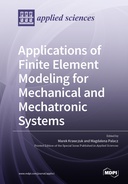Explore

Applications of Finite Element Modeling for Mechanical and Mechatronic Systems
0 Ungluers have
Faved this Work
Login to Fave
Modern engineering practice requires advanced numerical modeling because, among other things, it reduces the costs associated with prototyping or predicting the occurrence of potentially dangerous situations during operation in certain defined conditions. Thus far, different methods have been used to implement the real structure into the numerical version. The most popular uses have been variations of the finite element method (FEM). The aim of this Special Issue has been to familiarize the reader with the latest applications of the FEM for the modeling and analysis of diverse mechanical problems. Authors are encouraged to provide a concise description of the specific application or a potential application of the Special Issue.
This book is included in DOAB.
Why read this book? Have your say.
You must be logged in to comment.
Rights Information
Are you the author or publisher of this work? If so, you can claim it as yours by registering as an Unglue.it rights holder.Downloads
This work has been downloaded 143 times via unglue.it ebook links.
- 143 - pdf (CC BY) at Unglue.it.
Keywords
- Abaqus
- active periodic structures
- adaptivity
- Almen intensity
- aluminum conductor steel-reinforced cable
- applied load
- aramid fiber
- assessment
- bell crank
- bend deformation
- bias tire
- Biomechanics
- carbon fiber
- channel
- collision modeling
- contact detection
- Convergence
- crack detection
- cut bar method
- damage
- damage detection
- delamination
- Design
- design of experiment
- Detection
- Disability
- drill pipe joint
- driver
- electro-mechanical systems
- endogenous fires
- equilibrated residual method
- experiment
- fatigue fracture
- FEA
- FEM
- finite element analysis
- Finite element method
- finite element modeling
- Finite elements
- Finite Elements Analysis (FEA)
- finite volumne method
- first-order models
- friction coefficient
- generative modelling
- HALE UAV
- head injury
- heat lakes
- hierarchical models
- high peening coverage
- hp-adaptivity
- hpq/hp-approximations
- hybrid composite
- inflation analysis
- injury criteria
- local behaviors
- longwall
- low loading
- mechanical parameters
- misalignment
- natural frequency
- nondestructive inspection
- numerical locking
- numerical modeling
- Numerical Simulation
- NURBS
- p-enrichment
- PCHE
- piezoelectrics
- quantitative description of peening coverage
- residual compressive stress
- resolution
- Reverse engineering
- roll-to-roll process
- Rubber
- Safety
- sealing properties
- sensitivity analysis
- SFEM
- shot peening
- shrinkage
- single-sided
- Smart materials
- Solid Mechanics
- Spontaneous Combustion
- steady-state
- strain deviation
- Stress
- stress gradients
- surface profile
- swingarm
- Technology, engineering, agriculture
- Technology: general issues
- textile cord
- thermal conductivity
- thin-layer composite structure
- three-wheel motorcycle
- topology optimization
- torsion springs
- transition models
- turbine blade
- underground coal mine
- utilization factor
- ventilation system
- vibrometer
- web deformation
- Wind loads
Links
DOI: 10.3390/books978-3-0365-1556-4Editions

